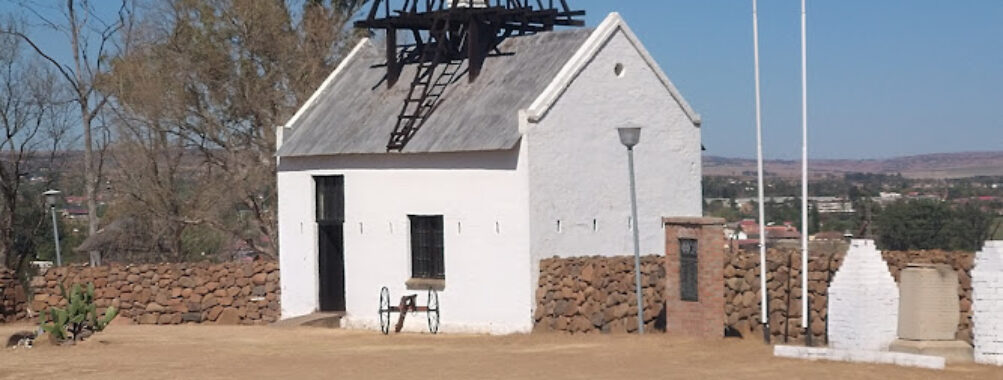
Fort Amiel Museum
Table of Contents
Description
Fort Amiel Museum is one of those places that quietly surprises you. At first glance, it looks like a modest historical site, but once you step inside, the stories and artifacts start pulling you back in time. This old military fort, originally built in the late 1800s, has been carefully preserved and turned into a museum that highlights the daily lives of soldiers, settlers, and the communities that shaped the region. It’s not a flashy, high-tech museum with touchscreens and neon signs—it’s more down-to-earth, the kind of place where you feel connected to the past in a very real, almost tactile way.
For history buffs, especially those interested in the Anglo-Zulu War and colonial South Africa, the museum is a treasure trove. The displays include uniforms, weapons, photographs, and personal items that belonged to soldiers. But beyond the military side, there’s also a strong emphasis on the human stories—the hardships, the resilience, and the cultural intersections that defined the period. What stood out to me was how approachable the whole experience felt. You don’t need to be a historian to get something meaningful out of it. Even kids seem to enjoy wandering around, partly because the fort itself feels like a bit of an adventure playground (with a lot more substance, of course).
The atmosphere is calm and welcoming, and accessibility has clearly been thought through. Wheelchair users will find it manageable, with ramps and accessible restrooms available. Families will appreciate that it’s child-friendly without being overwhelming. It’s not perfect—some exhibits could use a bit more polish or updated signage—but the charm lies in its authenticity. You’re not just looking at history from a distance; you’re standing in it.
Key Features
- Authentic 19th-century fort structure preserved as a museum
- Exhibits focusing on the Anglo-Zulu War and colonial frontier life
- Collection of original weapons, uniforms, and personal artifacts
- Engaging displays that highlight both military and civilian stories
- Wheelchair accessible entrance, restrooms, and parking
- Child-friendly environment with open spaces to explore
- Knowledgeable staff and guides who add personal context to the history
- Quiet atmosphere away from crowded tourist hubs
Best Time to Visit
The museum is open year-round, but honestly, the best time to visit depends on what kind of experience you’re after. If you prefer cooler weather and a more comfortable stroll around the grounds, the winter months (June to August in South Africa) are ideal. The air is crisp, and you can take your time without breaking a sweat. On the other hand, spring (September to November) brings a lovely freshness to the area, with greenery making the fort surroundings feel especially inviting.
I’d personally avoid the peak summer afternoons—not because the museum isn’t enjoyable, but because the sun can be relentless, and there’s only so much shade on the grounds. Mornings and late afternoons are the sweet spot if you’re visiting in summer. And if you’re the type who loves a quieter, less crowded experience, weekdays are your friend. Weekends can bring in more families and tour groups, which is great for atmosphere but not if you’re looking for peace and quiet.
How to Get There
Reaching the Fort Amiel Museum is relatively straightforward if you’re already in KwaZulu-Natal. The fort sits on a hill overlooking the town, so you’ll likely need a car or taxi to get there. Public transport options aren’t the most reliable in this part of South Africa, so self-driving is the best bet. The road leading up to the fort is in decent condition, though a little narrow in places, so take it slow if you’re not used to rural roads.
For those who enjoy a bit of scenery along the way, the drive itself is part of the experience. You’ll pass through rolling hills and countryside that give you a sense of what this land might have looked like back in the 1800s. Parking is available on-site and, importantly, it’s accessible for those with mobility challenges. If you’re coming from further afield, it’s worth combining a visit with other nearby attractions in the region, making it part of a day trip rather than a stand-alone outing.
Tips for Visiting
Here’s the thing about Fort Amiel Museum—it’s not the kind of place you rush through. To get the most out of it, give yourself at least an hour or two. That way, you can wander the grounds, linger over the exhibits, and maybe even chat with the staff who usually have fascinating tidbits to share.
Bring water, especially if you’re visiting in the warmer months, because while there are restrooms available, there isn’t a restaurant or café on-site. A small picnic isn’t a bad idea either, and the open grounds make for a pleasant spot to sit and take in the view. Comfortable shoes are a must since you’ll be walking on uneven ground in some areas. And don’t forget your camera—the fort has some pretty striking vantage points over the surrounding landscape.
If you’re traveling with kids, prepare them with a little backstory beforehand. A quick chat about forts, soldiers, or the Anglo-Zulu War can make the visit more engaging for them. For history enthusiasts, I’d suggest reading up a bit before going. That way, when you see certain artifacts, you’ll already have some context, and the experience becomes even richer.
One final tip: be open to the imperfections. This isn’t a glossy, modern museum with interactive screens and polished displays. It’s more rustic, more personal, and that’s exactly where its charm lies. If you go in expecting a polished tourist attraction, you might be underwhelmed. But if you’re ready to step into a piece of living history, you’ll probably walk away with a deeper appreciation for the stories that shaped this corner of South Africa.
Location
Places to Stay Near Fort Amiel Museum
Find and Book a Tour
Explore More Travel Guides
No reviews found! Be the first to review!